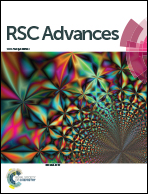Synthesis of a hierarchical MoSe2/C hybrid with enhanced electrochemical performance for supercapacitors
Abstract
A facile one-step hydrothermal strategy was successfully developed to fabricate a 3D hierarchical MoSe2/C hybrid with triethylene glycol as a structure-directing agent and carbon source. The products were characterized by X-ray diffraction (XRD), scanning electron microscopy (SEM), energy dispersive X-ray spectroscopy (EDS), high-resolution transmission electron microscopy (HRTEM), Raman spectroscopy and nitrogen adsorption–desorption. The experiment results indicate that the hierarchical porous MoSe2/C hybrid is composed of numerous few-layered MoSe2 nanosheets and amorphous carbon derived from the decomposition of the triethylene glycol. As a consequence, the obtained hierarchical MoSe2/C electrode exhibited superior electrochemical supercapacitive performances such as high specific capacitance, excellent cyclic stability and significantly enhanced rate capability in comparison with the bare MoSe2. The prominent electrochemical performance could be attributed to the robust hierarchical porous architectures with large surface areas and effective integration with conductive amorphous carbon.


 Please wait while we load your content...
Please wait while we load your content...